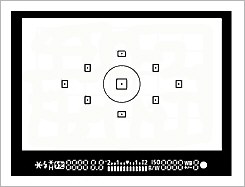

Canon EOS Digital Rebel XSi (EOS 450D) Review
Digital Sensor and Resolution
The Digital Rebel XSi uses a new CMOS sensor with 12.2 million pixels and a maximum image resolution of 4272 x 2848 pixels. This is about 20% than the 10.1 MP sensors used in the Digital Rebel XTi and EOS 40D (3888 x 2592 pixels) but 20% less than the new EOS 50D (4752 x 3168 pixels). In theory, a 20% increase in pixel count should give about a 9.5% increase in resolution. That's enough to detect, but not enough to be really noticeable unless you're looking at a very large print.
In practice, there's not a very noticeable difference in image resolution as you can see from the sample images below. These are 100% crops from JPEGs taken using the standard default parameters for sharpness with each camera. The crops are from the center of the image. The lens used was the EF300/4L at an aperture of f8 (at which the lens is very sharp). [In case you're wondering, these images are of part of a FedEx dropbox!]

The Rebel XSi may have a slight resolution edge, but remember these crops represent looking at sections of a very large image, probably something around 24" x 36" on a typical monitor screen. Despite the fact that both the EOS 40D and Digital Rebel XTi have the same pixel count, the EOS 40D image looks a little sharper. In all three cases, resolution may be increased slightly when capturing in RAW mode and making the optimal conversion to JPEGs. Here's a real world sample:

This was shot using an EF-S 55-250/4-5.6IS lens (hand held) at 171mm at a shutter speed of 1/250s, and aperture of f8 and an ISO speed setting of 100. The full image is shown on the left and the area outlined in red is shown as a 100% crop on the right. As you can see, there's plenty of detail resolved.
Below is a shot of a resolution test target (see my a resolution testing page). This is a 100% crop and the "2.8" line group represents about 75 lp/mm. This level of resolution is quite consistent with that expected from a 12MP sensor. 75 lp/mm corresponds to about 2250 LWPH (line widths per picture height) for the XSi, if you prefer those units!).

Digital Rebel XSi, ISO 100, EF-S 18-55, 55mm @f8
Self Cleaning Sensor

The Digital Rebel XSi has "anti-dust" features built into the sensor, which includes an anti-static coating and an ultrasonic shaker to dislodge dust particles. There's also a software mapping function, which can be used to minimize the visibility of dust particles if for some reason you can't clean the sensor or you want to be absolutely sure of minimizing the effects of dust. Although these features can't guarantee there will be no dust on the sensor, they do keep the amount of dust down and that means that any need for physical cleaning of the sensor will be much less frequent.
Viewfinder
 The Digital Rebel XSi viewfinder is slightly larger than that of the XTi, but slightly
smaller than that of the EOS 40D/50D. The difference from the XTi is fairly small and you
might not even notice it unless you compared the cameras side by side. The XSi viewfinder
also seems slightly brighter than that of the XTi, but again the difference is small. Both
the XSi and XTi use a pentamirror system rather than the more expensive and heavier (but
slightly brighter) pentaprism system used on the EOS 40D/50D
The Digital Rebel XSi viewfinder is slightly larger than that of the XTi, but slightly
smaller than that of the EOS 40D/50D. The difference from the XTi is fairly small and you
might not even notice it unless you compared the cameras side by side. The XSi viewfinder
also seems slightly brighter than that of the XTi, but again the difference is small. Both
the XSi and XTi use a pentamirror system rather than the more expensive and heavier (but
slightly brighter) pentaprism system used on the EOS 40D/50D
As with the EOS 40D/50D, the Digital Rebel XSi displays the ISO setting in the viewfinder at all times, as well as the usual information such as exposure compensation, shutter speed, aperture, flash status, buffer frames remaining (when that number is 9 or less), AF status, high speed sync setting, flash exposure compensation setting and exposure lock indication.
The XTi and XSi have the same 9 AF zone markings, but the XSi viewfinder adds a center circle marking, which defines the 4% area covered by the new spotmeter in the XSi.
XSi Viewfinder Specifications
- Coverage - Vertical/Horizontal approx. 95%
- Magnification - Approx. 0.87x (-1m with 50mm lens at infinity)
- Eyepoint - Approx. 19mm (from eyepiece lens center)
- Dioptric Adjustment Correction -3.0 to +1.0 diopter
